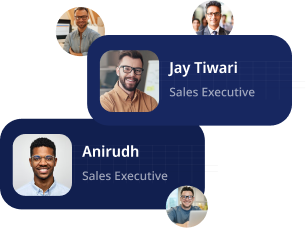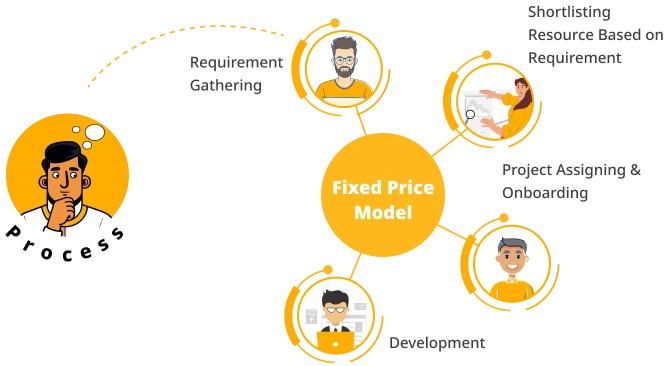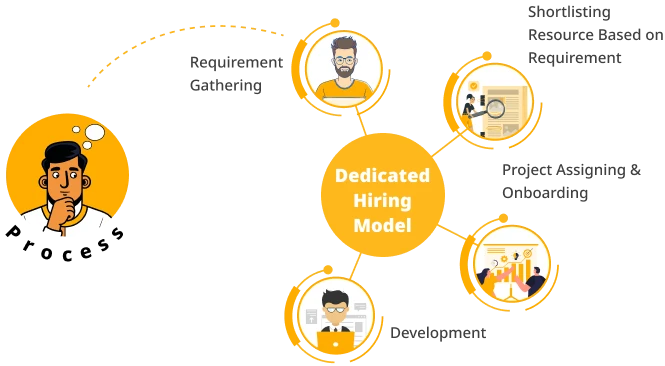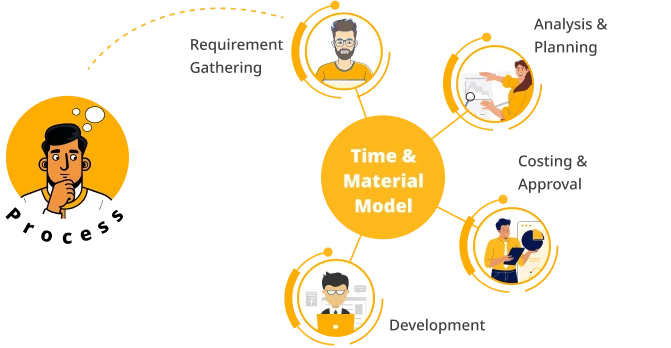Upgrade, modernize, and scale your web and mobile apps with ValueCoders’ Application Migration & Modernization services. We offer on-premise, hybrid, and cloud-based solutions across various platforms, ensuring seamless and efficient application performance.

Professional, reliable, and results-driven – they delivered exactly what we needed, on time and within budget.
- James
Software migration and modernization are crucial in a dynamic market condition. At ValueCoders, we develop an incremental development roadmap for application migration & modernization.
We review your business’s existing applications and suggest if any OS updates or system migration is required.
We help with migration from one platform to another, one technology to another, and one domain to a different one.
We provide UI modernization & migration to maintain a consistent UX across smartphones, tablets, laptops, and desktops.
As a top digital transformation company, we give your business a digital edge through app migration and modernization services.
We work on your legacy applications and migrate them to the cloud per your business requirements. Our legacy application migration services include:
Whether you need data transferred from website APIs to mobile APIs, different web APIs to host APIs, or API upgrades, our team provides API migration services:
Our hands-on development expertise increases your core business system efficiency and reduces technical debt.
We help organizations modernize their existing applications by giving recommendations and making a roadmap for a more modern and efficient workflow.
ValueCoders modernizes and migrates your applications for improved performance, scalability, and innovation.

Faster time to market with customer delight and continuous evolution amid uncertainties are the most pressing concerns of companies. As an application modernization company, we understand your challenges and work as a team to overcome them.
There are various common concerns businesses often face, such as:
Considering your common and specific challenges, we respond with:
ValueCoders provides reliable application migration and modernization services with faster turnaround times and better ROI.
We have a team of highly professional and dedicated developers who deliver best-in-class and innovative results.
Let's break down complex IT issues into actionable solutions you can understand.
Partnering with businesses in diverse sectors to unlock new avenues for growth and innovation.
We have been delivering application migration and modernization services to startups, SMBs, agencies, and enterprises since 2004.
Choose from our flexible hiring models designed to fit your needs and budget.
For businesses with well-defined project scope and requirements.

For businesses with long-term project requirements or complex development process. They get more control of the process.

For businesses looking to pay for completed project instead of committing to fixed project cost.

Quick Overview In this comprehensive guide, you’ll learn how to efficiently migrate your Java applications to Python for modernization. This…
Learn MoreThis is a web-based CRM tool that can be used on any browser, free from any installation on the system.
It is a low-code/no-code, a cloud-native platform that enables you to develop mission-critical apps 20 times faster than traditional methods, leveraging the power of SAP's digital core from any device, with or without connectivity.
Quick Overview As business infrastructures struggle to meet evolving demands, cloud migration offers transformative solutions for efficiency, innovation, and growth. …
Learn More
Application migration and modernization are two concepts that can be distinguished in the field of software development, as discussed below:
Application Migration
It is a process by which an application is moved from one environment to another. This involves moving an application from an older or outdated infrastructure/platform/ technology stack to a new environment.
This also involves migrating an application from on-premises servers to the cloud, moving from one hosting provider to another, or changing to a different operating system or database.
Application Modernization
It involves updating or transforming an existing application to use new technologies, improve functionality, enhance user experience, and align with current business needs.
Modernization is an approach to extending an application’s lifespan and value through the adoption of modern development practices, architectures, and frameworks.
Refactoring or rewriting code, redesigning the user interface, optimizing performance, integrating new features, adopting cloud-native technologies, and implementing microservices architecture
In conclusion, both approaches are good for improving applications’ performance, scalability, security, and lifespan.

Migrating application types depends on factors such as desired results, the complexity of the application, budget limitations, and the disruption a business can take. Before any application migration, you should have the correct assessment of an application’s needs and proper planning involved.
There are different types of application migration depending upon different scenarios and needs, as given below:
Lift-and-Shift Migration: Application migration takes the application as-is from one environment to another with minimal changes. It often involves transferring applications from on-premises infrastructure to the cloud or between different hosting providers.
The focus is on achieving better scalability, cost-effectiveness, and management convenience without altering the application’s core functionality.
Replatforming: Migrating an application requires almost no changes to the existing code. It primarily occurs when one moves their application into a new platform or infrastructure where much functionality is available or support better exists, from a previous version of the database to a later one or from a legacy server to containerization.
Refactoring: Refactoring migration is the process of making significant changes to an application’s architecture, design, or codebase while migrating to a new environment. The aim is to optimize the application for the target platform, improve performance, scalability, or maintainability, and adopt modern development practices.
This includes rewriting specific modules, redesigning the database schema, or adopting new frameworks or libraries.
Re-architecting: Re-architecting migration involves a more substantial overhaul of the application’s architecture and design. It may include breaking down a monolithic application into microservices, adopting a service-oriented architecture (SOA), or transitioning to a cloud-native architecture.
This type of migration aims to improve scalability, resilience, and agility by leveraging modern architectural patterns and technologies.
Hybrid Migration: Hybrid migration refers to a combination of on-premises and cloud-based components. This allows for a gradual migration approach, where some parts of the application can be moved to the cloud while others remain on-premises.
Hybrid migration is flexible and allows businesses to leverage the benefits of the cloud while maintaining legacy systems or sensitive data on-premises.

The selection of the modernization approach depends on factors including the application’s current state, business goals, budget, and time constraints. All of the options should be assessed thoroughly, and an approach must be chosen that best fits the desired results and long-term goals of the application and the organization.
There are several types of application modernization approaches. Each focuses on different aspects of enhancing and updating the application, as discussed below:
Replatforming: It is a process in which an application is moved to a new platform offering better capabilities, scalability, and performance without making considerable changes to its codebase.
It typically involves moving to a cloud-based infrastructure or adopting a new hosting environment while maintaining the application’s core functionality.
Refactoring: Refactoring modernization focuses on improving an application’s internal structure, design, and codebase without altering its external behavior. By optimizing code, removing technical debt, and adopting modern development practices, it aims to enhance the application’s maintainability, extensibility, and performance.
Refactoring involves restructuring the application’s architecture, improving code quality, and adopting new frameworks or libraries.
Rearchitecting: Rearchitecting modernization involves rethinking and redesigning the application’s architecture to suit modern paradigms and technologies.
t involve transitioning from a monolithic architecture to a microservices or service-oriented architecture (SOA), breaking down the application into modular components, and adopting cloud-native patterns. Rearchitecting improves the application’s scalability, flexibility, and agility.
Rebuilding: Rebuilding modernization involves rewriting an application from scratch while keeping its core functionality and business logic. This involves using modern technologies, frameworks, and best practices.
Eliminating legacy code allows one to correct architecture deficiencies and build a better, more scalable, and maintainable application.
Replacement: Replacement modernization involves replacing the existing application with new commercial off-the-shelf (COTS) software or a customized solution. This approach is taken when an existing application no longer serves the business needs or when replacement is cheaper than modernization.

Application modernization can enhance adaptability to changing customer preferences and market dynamics in several ways:
Scalability: Modernized applications can easily scale to accommodate increased user loads or evolving business needs, ensuring a seamless customer experience during growth.
Agility: Modernized systems are more flexible and adaptable, allowing businesses to respond quickly to changing market demands and customer expectations.
Personalization: Advanced modernization can enable personalized user experiences, catering to individual customer preferences and improving engagement.
Data Insights: Modern applications can better harness and analyze data, providing valuable insights into customer behavior and helping businesses make informed decisions.
Real-time Updates: Modernized apps can receive real-time updates and enhancements, ensuring they remain current and aligned with market trends and customer expectations.
Multi-Channel Accessibility: Modernization can make applications accessible across various channels, meeting customers where they prefer to interact, whether it’s through mobile devices, the web, or other platforms.
Improved Performance: Modernized systems often deliver better performance and faster response times, providing a more satisfying customer experience.
Enhanced Security: With modernization, security measures can be strengthened to protect against evolving cybersecurity threats, instilling customer trust.
Integration Capabilities: Modern applications can integrate seamlessly with other tools and systems, enabling a more cohesive and efficient response to market changes.
Rapid Development: Modernization methodologies like DevOps and Agile allow for quicker development and release cycles, ensuring faster responses to changing requirements.

Application modernization can drive innovation and support the development of new revenue streams for your business in the following ways:
Enhanced Customer Experience: Modernized applications offer improved user experiences, attracting new customers and retaining existing ones, increasing revenue.
New Features and Services: Modernization enables introducing new features and services, expanding the range of offerings and creating opportunities for additional revenue.
Data Monetization: Modernized applications can better leverage data, allowing businesses to monetize valuable customer insights and analytics.
Market Expansion: Modernization can facilitate entry into new markets or customer segments, broadening the customer base and revenue potential.
E-commerce Optimization: For businesses with e-commerce platforms, modernization can improve the online shopping experience, leading to higher sales and revenue growth.
Streamlined Processes: Modernization can optimize internal processes, reducing operational costs and freeing up resources for revenue-generating activities.
Faster Time-to-Market: Agile modernization approaches enable quicker product development and launches, helping businesses capitalize on market opportunities faster.
Mobile and IoT Integration: Modernization can enable integration with mobile and IoT technologies, creating new revenue opportunities in the mobile app and connected device markets.
Subscription Models: Businesses can introduce subscription-based revenue models or tiered pricing structures, generating recurring revenue streams.
Cross-selling and Upselling: Modernized applications can support cross-selling and upselling strategies by suggesting related products or services to customers, increasing average transaction values.
Here are answers to some questions which our clients frequently have in their mind.
Ans. There are a lot of reasons you must know before choosing us for application modernization. We have a strong track record of successful projects and a team of experienced app developers who are well-versed in the latest mobile/web technologies.
Besides these, many more reasons make us the perfect fit for application modernization. So, if there is any requirement, consult with our experts now
The cost of our application modernization services varies based on the following factors:
We need to assess your application and discuss your requirements to provide an accurate cost estimate. You may also contact us directly for a personalized quote tailored to your business needs.
Ans. At ValueCoders, we believe in developing responsive applications as per the changing business needs and emerging opportunities.
Some of the most significant technologies we are using for application modernization include:
Ans. The Recovery Time Objective is the time that elapses before an application migration service returns to normal following a disaster. The application migration service can reduce RTO substantially if it is well-designed and implemented.
To reduce the recovery time, applications and data are replicated across multiple locations, and deployment process automation is adopted.
In addition, a good testing process will ensure that any potential problems are identified and resolved before they cause an outage.
Ans. Technologies are changing rapidly, and older application architectures cannot take advantage of the innovation.
There are some key reasons why companies need to modernize their applications:
In short, companies need to modernize their applications to match the competitive market and make the app user-friendly.
We are grateful for our clients’ trust in us, and we take great pride in delivering quality solutions that exceed their expectations. Here is what some of them have to say about us:

Co-founder, Miracle Choice

Executive Director

Director

Director
Trusted by Startups and Fortune 500 companies
We can handle projects of all complexities.
Startups to Fortune 500, we have worked with all.
Top 1% industry talent to ensure your digital success.



Let's discuss how we can bring your vision to life.